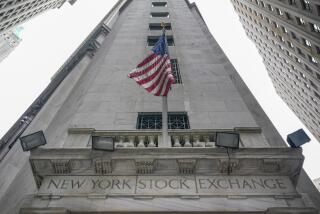Big Taxpayer Bailout of Banks Feared : Finance: Concern is growing on Capitol Hill that a costly Bush proposal to replenish the bank deposit insurance fund is really a bailout in disguise.
- Share via
WASHINGTON — Fears in Congress mounted Wednesday that a huge taxpayer bailout of the banking industry is becoming more probable, raising the potential for a rescue effort that could turn out to be much like the costly S&L; debacle before it.
The new congressional concerns came as leaders on Capitol Hill began to study the Bush Administration’s costlier-than-expected proposal to replenish the bank deposit insurance fund run by the Federal Deposit Insurance Corp.
The plan calls for a massive increase in the FDIC’s credit line with the government, to provide an infusion of up to $70 billion for the deposit insurance fund, for use in case of the collapse of one or more of America’s biggest banks. During the past four years, 800 banks have been closed by the FDIC, costing the agency $23 billion, and the fund now has been left with just $8.5 billion.
Currently, the banking industry finances the fund with premium payments, but the Administration plan calls for a big line of credit from both the Treasury Department and the Federal Reserve Board to provide new backing for the fund in case it runs dry. The Bush plan calls for the banking industry to eventually repay any money borrowed by the fund from the government.
But top congressional critics of the plan say that it represents an attempt to hide the fact that the Bush plan represents a bailout for the banking industry.
“The people are beginning to smell a new taxpayer bailout,” charged Rep. Henry B. Gonzalez, chairman of the House Banking Committee.
“It is absolutely essential that the recapitalization of the (fund) be carried out in a rational, straightforward manner that maintains the confidence in the nation’s financial system,” he added. “I think we must avoid a rerun of the shifting numbers, the gimmickry and the outright deceit that marked so much of the savings and loan crisis in the 1980s.”
Meanwhile, in an interview, the head of the General Accounting Office, the congressional watchdog agency, also charged that the Administration is not being candid about seeking a bailout.
“We’ve seen a very large (deposit insurance fund) almost disappear on us,” said Charles A. Bowsher, U.S. Comptroller General and head of the GAO. “They are talking about government money to be repaid later by the banks, but in all of the bailout situations I have been involved with in various government jobs, dating back to the Penn Central case, the bailouts end up being more costly the closer you look at them.
“I think the Administration should stop kidding themselves,” Bowsher charged. “If we have to solve this banking crisis, we ought to do it straight away and do it in an up front way.”
Bush Administration officials deny, however, that their plan for the insurance fund represents a bailout. In fact, Treasury Secretary Nicholas F. Brady said this week that the banking industry will not need such a government effort, because banks have much greater capital reserves than the savings and loan industry ever had. Banking executives also heatedly deny that there are any parallels between their industry’s troubles and those that plagued the thrifts during the past few years.
But Bowsher and Gonzalez indicated that their warnings are based on a sense that big taxpayer bailouts often start with a relatively modest government involvement.
More to Read
Get the L.A. Times Politics newsletter
Deeply reported insights into legislation, politics and policy from Sacramento, Washington and beyond. In your inbox three times per week.
You may occasionally receive promotional content from the Los Angeles Times.










